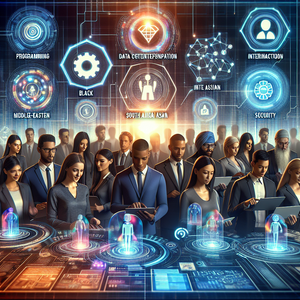The Forgotten Generation in the Digital Age: Bridging the Digital Divide for Older Adults

For many older adults, the rapid evolution of technology can feel like an insurmountable challenge. Unlike millennials and Gen Z, who have grown up immersed in digital tools, seniors were introduced to this landscape later in life, often without formal education or guidance. As a result, foundational digital skills—such as using a smartphone, navigating the internet, or sending an email—can feel foreign and intimidating. Practical barriers exacerbate the issue. Access to technology is not universal, and many seniors, particularly those in rural or low-income areas, may lack access to devices or reliable high-speed internet. Physical limitations, such as impaired vision, hearing, or dexterity, can make using technology even more difficult. Beyond these logistical hurdles, psychological barriers also play a role. Many older adults report feeling intimidated by the fear of making mistakes or falling victim to online scams, leading to hesitancy and avoidance of digital tools. The consequences of this digital divide are significant. Without digital literacy, older adults often struggle to access essential services, such as telehealth appointments, online banking, or government resources. Social isolation, already a common issue among seniors, is further exacerbated by the inability to connect with friends and family through digital platforms like social media or video calls. These challenges contribute to feelings of frustration, loneliness, and alienation, negatively affecting their mental health and overall quality of life.
Bridging the Gap: The Power of Intergenerational Mentorship
One of the most promising solutions to address the digital divide for older adults is fostering intergenerational mentorship programs. Younger generations, who are typically fluent in using technology, can play an invaluable role in helping seniors develop digital skills. Programs that pair tech-savvy youth with older adults are already proving successful in communities worldwide. For example, initiatives like "Cyber Seniors" and "Tech Buddies" connect teenagers or college students with older adults for one-on-one tutoring sessions. These sessions focus on practical skills, such as setting up email accounts, using video conferencing platforms, or navigating online services. Beyond teaching technical skills, these programs foster meaningful relationships between generations, breaking down stereotypes and promoting empathy. The benefits of intergenerational mentorship are twofold. Older adults gain confidence and independence as they acquire digital literacy, while younger mentors develop soft skills such as patience, communication, and a sense of community responsibility. These partnerships highlight that closing the digital divide is not just about technology—it’s about building bridges between people.
Tailored Learning Programs for Seniors
Another critical component in bridging the digital gap is the creation of educational programs specifically tailored to the needs of older adults. Unlike traditional computer courses, which may move too quickly or assume prior knowledge, these programs focus on practical, real-life applications of technology. This approach allows seniors to learn at their own pace and apply their new skills in meaningful ways. For instance, many public libraries, senior centers, and community colleges now offer workshops designed exclusively for older adults. These classes often cover essential topics, such as how to use a smartphone, conduct secure online transactions, or video chat with loved ones. Hands-on learning, user-friendly materials, and step-by-step guidance are emphasized to make the experience less intimidating. Organizations like AARP have also stepped up to provide online tutorials and resources tailored to seniors. These resources allow older adults to learn on their own schedule and revisit topics as needed, ensuring they feel comfortable and confident in their skills. Such programs not only teach seniors how to use technology but also empower them to engage with the digital world independently.
The Role of User-Friendly Technology
While education and mentorship are critical, technology companies also play a vital role in ensuring that their products are accessible to all generations. Unfortunately, many digital tools are designed with younger, tech-savvy users in mind, which can alienate older adults. However, an increasing number of companies are recognizing the need for inclusivity and are designing devices and platforms specifically with seniors in mind. For example, smartphones like the Jitterbug prioritize simplicity, featuring large buttons, easy-to-navigate menus, and emergency response features. Voice-activated assistants, such as Amazon Alexa or Google Assistant, allow older adults to perform tasks like setting reminders, listening to music, or controlling smart devices without needing to navigate complicated interfaces. Accessibility features like adjustable font sizes, screen magnifiers, and text-to-speech capabilities also help make technology more user-friendly. Emerging technologies hold even greater potential. Virtual reality (VR) programs, for instance, are being developed to help seniors "travel" to far-off destinations, participate in immersive therapy, or even engage in social activities without leaving their homes. Such innovations show how technology, when thoughtfully designed, can significantly improve the lives of older adults.
As society continues to digitize, digital literacy is no longer a luxury—it’s a necessity. Ensuring that older adults are not left behind in this transformation requires a collective effort from governments, nonprofits, tech companies, and communities. By promoting intergenerational mentorship, developing tailored educational programs, and designing inclusive technology, we can create a digital landscape that welcomes everyone, regardless of age. Empowering seniors to embrace technology offers far-reaching benefits. It enhances their quality of life, reduces feelings of isolation, and helps them maintain independence. At the same time, it strengthens society as a whole by fostering connections between generations and ensuring equal access to the opportunities of the digital age. The digital revolution should be a bridge, not a barrier. By addressing the unique challenges faced by older adults, we can ensure that the "forgotten generation" finds its place in this new world. Together, we can create a future where technology connects and empowers people of all ages, leaving no one behind.
Digital Literacy Program Coordinator
Nonprofits, community organizations, and local government agencies
Core Responsibilities
Design and implement digital literacy training programs tailored for older adults.
Collaborate with community centers, libraries, and nonprofits to deliver accessible workshops.
Evaluate program effectiveness through participant feedback and measurable outcomes.
Required Skills
Strong background in adult education or instructional design.
Familiarity with digital platforms, including smartphones, tablets, and basic productivity tools.
Excellent communication and interpersonal skills to engage older learners.
Accessibility UX/UI Designer
Tech companies like Apple, Google, or startups specializing in senior-focused technology
Core Responsibilities
Create user-friendly digital interfaces that accommodate older adults and individuals with accessibility needs.
Conduct user research with seniors to understand their unique challenges and preferences.
Develop features like voice navigation, screen magnification, and simplified interfaces.
Required Skills
Expertise in accessibility standards (e.g., WCAG) and inclusive design principles.
Proficiency in design tools like Figma, Sketch, or Adobe XD.
Experience in usability testing with diverse populations, particularly older adults.
Intergenerational Program Facilitator
Community centers, nonprofits like Cyber Seniors, and education-focused organizations
Core Responsibilities
Develop and oversee mentorship programs that pair tech-savvy youth with older adults.
Organize training sessions, workshops, and community events to foster meaningful interactions.
Track program success by monitoring digital skill improvements and participant satisfaction.
Required Skills
Strong program management and event coordination skills.
Experience working with both seniors and youth populations.
Knowledge of intergenerational learning models and social impact strategies.
Assistive Technology Specialist
Healthcare organizations, rehabilitation centers, and assistive tech companies
Core Responsibilities
Assess the needs of older adults and recommend appropriate assistive technologies.
Provide hands-on training for devices such as voice-activated assistants, adaptive keyboards, or screen readers.
Stay updated on emerging technologies designed for accessibility and aging populations.
Required Skills
Deep understanding of assistive devices and accessibility features in mainstream technology.
Ability to teach and troubleshoot technology for individuals with varying levels of technical expertise.
Certification in assistive technology (e.g., ATP credential) is a plus.
Aging and Technology Research Specialist
Universities, think tanks, and research institutions exploring aging and technology
Core Responsibilities
Conduct research on the intersection of aging and technology, focusing on barriers to adoption and solutions.
Publish studies and reports to guide policymakers, tech companies, and nonprofits.
Partner with stakeholders to pilot initiatives that bridge the digital divide.
Required Skills
Advanced knowledge of gerontology, sociology, or human-computer interaction (HCI).
Experience in qualitative and quantitative research methodologies.
Ability to translate data into actionable recommendations for diverse audiences.


